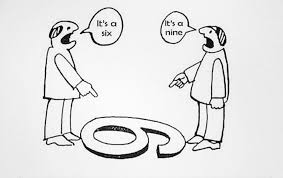Research blog: Perspective

Figure 1: Still of perspectivism: https://en.englishlib.org/dictionary/en-cn/perspectivism.html
Perspectivism is defined by Miriam Webster as either "the world forms a complex of
interacting interpretive processes in which every entity views every
entity and event from an orientation peculiar to itself" or "consciousness of or the process of using different points of history". At this present moment, this is the core focus of my final project, as the protagonist has a unique perspective that allows him to see certain things in objects that other people cannot see. A perspective is used to tell how the main figure we focus on sees a situation.
Perspectives in film are essential because they will determine how the audience will perceive the visual world a film creates. The point of view will remind us who is telling the character's story, and how the audience feels about the story will change depending on who is telling that story. In a scene featured in a dining room where a husband and wife argue, and a sister is playing in the kitchen with a baby, the scene would have an objective view should the camera capture both actors in the frame. But if the camera is set at the perspective of the husband, it becomes subjective because the director instructs us to care more about him than the wife. The way to make the shot completely subjective would be to shoot the film as if the cameras were directly in the man's eyes.
The point of view in a film is expressed in a shot, and changing the point of view can directly change how the audience feels about a scene and a story. Determining the point of view is one of the director's most significant contributions to a story. (McGregor, L. 2022)
A first-person perspective restricts the audience to the view that they see from a single character. This perpsective should not be extensively adhered to because we cannot get the reactions of the other characters that this person interacts with. This is focusing on the characters that we see rather than the character who sees them. The first-person is told from a personal perspective and is commonly used in essays, short stories and novels.
The second-person perspective focuses on the "you" in the story, and forces the audience to become a participator in the story. This perspective can really only be conveyed in writing, and is hard to work with after a certain period of time.
A third-person perpsective views the situation as an ideal observer, and is the most-frequently used perspective in film and television. Examples of this include an over-the-shoulder shot and a mid-shot of two characters communicating. The purpose of the third person is to create distance between the reader and the writer, and allows the writer to create a story at distance.
An omniscient point-of-view reveals what the figures in a scene are thinking, and is usually accompanied by narration, voice-over or graphics. This requires a visual connection of the character to be provided to the audience. The filmmaker can combine this range of perspectives to make the story more engaging.
A point-of-view is usually inferred by an audience, and the perpsective utilised will have a huge impact on the plot of the intended story.
A pov shot is a camera angle that shoots a scene from the view of a specific character, and is used to show the audience what the character is witnessing. The shot after this is used to indicate the character's reactions to this event, which is necessary to convey the emotional state of the scenario. Also known as a subjective state or first-person camera. Events witnessed in a point-of-view sequence could include a character viewing an event, the event unfolding in real time or a shot returning to the main focus of a scene.
POV shots are mainly used when the director wants to carry emotions to a particular scene and direct the audience's attention, and must be used only when necessary. A perspective shot can be used in an action sequence to heighten the tension, as well as when the director needs to convey the challenge established for the protagonist. This is particularly effective when the subject in a perspective shot is not human, such as a robot, or alien, and a scene portraying their vision can help establish this. Perspective shots are also necessary to show when a character is in an altered mental state, and can be used to display the effects of heroin on the eyes, or a character entering a separate dimension. This type of shot can also be used to hide an object from the audience to create suspense, or even show the perspective of an object that is being handled by the characters to gain their reactions.
The type of POV shot utilised will depend on what the director wants to convey to the audience.

Figure 2: Ending shot on Inglourious Basterds (2009): http://storystruggles.blogspot.com/2018/03/camera-angles-objective-subjective-or.html
References
Heckmann, C., 2020. Why Point of View Matters in Storytelling. [online] StudioBinder. Available at: <https://www.studiobinder.com/blog/what-is-point-of-view-definition-literature/> [Accessed 6 October 2022].
McGregor, L., 2022. Understanding Point of View in Film and Video. [online] Premium Beat. Available at: <https://www.premiumbeat.com/blog/understanding-pov-in-film-and-video/> [Accessed 6 October 2022].
Team, N., n.d. Point of View Shot - Everything You Need to Know - NFI. [online] NFI. Available at: <https://www.nfi.edu/point-of-view-shot/> [Accessed 6 October 2022].

No comments:
Post a Comment